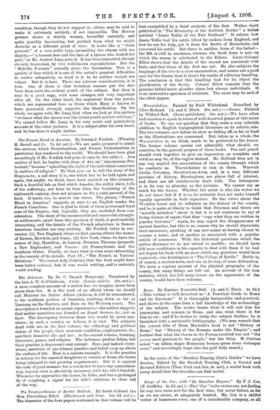Warwickshire. Painted by Fred Whitehead. Described by Clive Holland. (A.
and C. Black. 20s. net.) —Sussex. Painted by Wilfred Ball. (Same publishers. 20s. net.)—We have eften had occasion to speak in terms of well-deserved praise of this series of books. No one can question that they make a very valuable addition to English topographical literature on its artistic side. The two volumes now before us show no falling off, so far at least as the illustrations are concerned. But, taken as a whole, the Warwickshire is, we think, much to be preferred to the Sussex. The former volume carries out admirably what should, we conceive, be the general purpose of these books. Pen and pencil should work together to give an impression, as complete and vivid as may be, of the region desired. Mr. Holland does not in any way neglect the associations of the county through which he conducts us. Warwickshire is rich in them. Warwick Castle, Coventry, Stratford-on-Avon, and, in a very different province of history, Birmingham, are places full of interest, and these are all satisfactorily dealt with. The letterpress is in its way as pleasing as the pictures. We cannot say as much for the Sussex. Whether the artist is also the writer we do not know, but if it is so, he certainly does not make himself equally agreeable in both capacities. He has views about the Wealden forest and its influence on the history of the county, and he is quite at liberty to think that Freeman and Green are "notably mistaken" about it, but it is not courteous to say of living writers of repute that they "copy what they see written in popular histories." Again, be may regret the disappearance of ancient families, but this is no reason why he should depreciate their successors, speaking of one new-corner as having chosen to assume a name, and of another as associated with a popular article of commerce. With the historical questions which the author discusses we do not intend to meddle ; we should have felt more confidence in his capacity to deal with them if he had not begun his book with an error which any gazetteer would have corrected,—the frontispiece is "The Village of Battle." Battle is, of course, a market-town, and one, in its way, of some distinction. We have a copious account of the physical geography of the county, but many things are left out. An account of the iron industry, which has left many traces on the appearance of the county, would have been welcome.






































 Previous page
Previous page